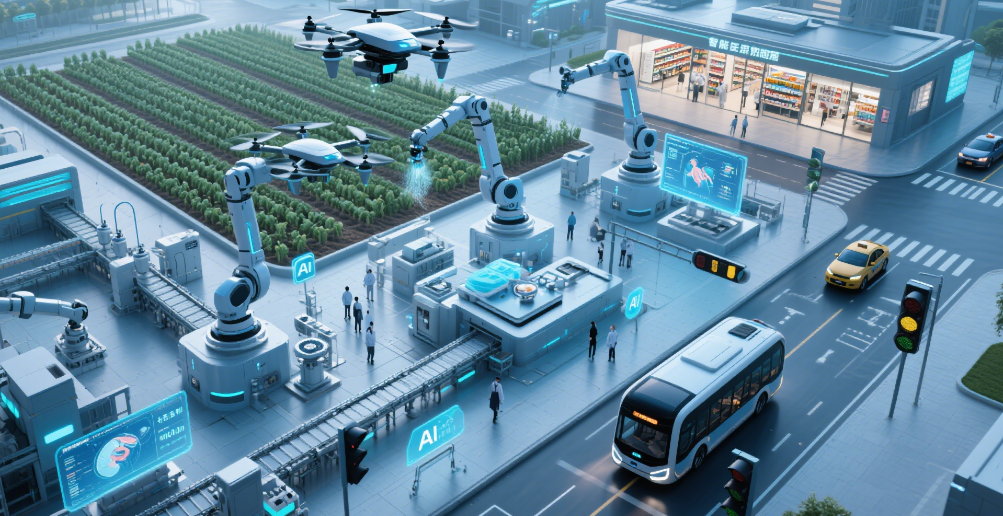AI Reinventing the Medical Ecosystem: From Technological Breakthroughs to Value Creation
观棋 2025-05-23
In the rapidly evolving landscape of healthcare, artificial intelligence (AI) has emerged as a transformative force, revolutionizing diagnostics, treatment planning, drug discovery, and patient care management. As we stand at the intersection of technological innovation and medical advancement, AI is not just optimizing existing processes—it's fundamentally reshaping how healthcare is delivered, experienced, and valued. This article explores the multifaceted impact of AI in healthcare, highlighting key breakthroughs and the profound value they create for patients, providers, and the global healthcare system.
In the rapidly evolving landscape of healthcare, artificial intelligence (AI) has emerged as a transformative force, revolutionizing diagnostics, treatment planning, drug discovery, and patient care management. As we stand at the intersection of technological innovation and medical advancement, AI is not just optimizing existing processes—it's fundamentally reshaping how healthcare is delivered, experienced, and valued. This article explores the multifaceted impact of AI in healthcare, highlighting key breakthroughs and the profound value they create for patients, providers, and the global healthcare system.
1. Diagnostic Precision: Elevating Clinical Decision-Making
One of AI's most tangible contributions lies in diagnostic accuracy. Machine learning algorithms, trained on vast datasets of medical images (X-rays, MRIs, CT scans), pathology slides, and clinical records, can detect subtle patterns that human observers might miss. For example, Google Health's AI system demonstrated superior performance in identifying lung cancer nodules compared to radiologists, reducing false positives by 11% and false negatives by 5%. Such tools don't replace clinicians but act as "super assistants," augmenting their capabilities to make faster, more reliable decisions.
In ophthalmology, AI-driven platforms like IDx-DR have gained FDA approval to detect diabetic retinopathy without human interpretation, enabling early intervention in underserved regions. These technologies address critical healthcare gaps by extending expert-level diagnostics to remote areas, where access to specialized radiologists or ophthalmologists is limited. By converting medical data into actionable insights, AI transforms diagnostic workflows from reactive to proactive, shifting the focus toward preventive care.
2. Drug Discovery and Development: Accelerating the Innovation Pipeline
The pharmaceutical industry faces significant challenges: an average 10-15 year timeline and $2.6 billion cost per drug approval, with high failure rates in clinical trials. AI is revolutionizing this pipeline by leveraging computational models to predict molecular interactions, simulate drug efficacy, and identify promising candidates. Companies like DeepMind and Insilico Medicine use deep learning to analyze protein structures (e.g., AlphaFold's breakthrough in predicting protein folding) and design novel molecules, cutting drug discovery timelines by up to 40%.
AI also optimizes clinical trial processes by identifying eligible patients faster through EHR analysis, predicting treatment responses, and monitoring adverse events in real time. This reduces trial costs and accelerates access to life-saving therapies. For instance, GSK used AI to analyze patient data and genetic markers, enabling more targeted recruitment for a respiratory disease trial, which reduced enrollment time by 30%.
3. Personalized Medicine: Tailoring Care to the Individual Genome
The era of precision medicine is being driven by AI's ability to process vast genomic, lifestyle, and environmental datasets. Machine learning algorithms can identify genetic predispositions to diseases, predict treatment outcomes based on an individual's molecular profile, and even design customized treatment plans. In oncology, tools like IBM Watson for Genomics analyze a patient's tumor genetics to recommend targeted therapies, improving response rates in metastatic cancer cases.
Beyond genetics, AI models parse longitudinal patient data—including EHRs, wearable device metrics, and lifestyle habits—to create predictive health profiles. These models can forecast disease risk (e.g., predicting heart attacks with 90% accuracy two years in advance, as shown in a 2024 study in Nature Medicine) and suggest personalized interventions, from diet plans to exercise regimens. This shift from "one-size-fits-all" care to individualized strategies promises higher efficacy and lower healthcare costs by preventing complications before they arise.
4. Enhancing Patient Experience and Accessibility
AI is democratizing healthcare through intuitive interfaces and scalable solutions. Chatbots and virtual health assistants (e.g., Babylon Health's AI triage tool) provide 24/7 symptom checking, appointment scheduling, and medication reminders, improving patient engagement and reducing administrative burdens. In telemedicine, AI-powered platforms analyze video consultations for non-verbal cues (e.g., facial expressions indicating pain) and speech patterns to enhance remote diagnosis, a critical innovation amplified by post-pandemic telehealth adoption.
For patients with chronic conditions, AI-driven monitoring systems (e.g., continuous glucose monitors for diabetes) generate real-time insights, enabling timely adjustments to treatment plans. These technologies empower patients to take active roles in their care, while providers gain remote visibility into health trends, reducing hospital readmissions and improving quality of life.
5. Ethical Frontiers and Challenges: Navigating the AI Healthcare Paradigm
While the opportunities are vast, AI adoption in healthcare raises critical ethical considerations. Bias in training data can lead to diagnostic disparities—for example, an AI algorithm trained predominantly on white patient populations may misdiagnose diseases in diverse ethnic groups. Ensuring transparency in AI decision-making ("explainable AI") and establishing robust regulatory frameworks (e.g., the EU's AI Act classification of healthcare AI as "high risk") are essential to building trust.
Data privacy also remains a top concern. As AI systems rely on aggregated patient data, strict safeguards must protect sensitive health information from breaches or misuse. Striking the balance between data utility and privacy will be key to sustaining public confidence in these technologies.
The Future: AI as a Collaborative Partner in Healthcare
The true promise of AI in healthcare lies not in automation, but in collaboration. Clinicians and AI systems work symbiotically: humans bring empathy, contextual understanding, and ethical judgment, while algorithms handle data-intensive tasks with speed and precision. As regulatory frameworks mature and technological literacy grows, we can expect AI to become an embedded component of healthcare—from smart hospitals with predictive maintenance and resource optimization to global health networks that leverage real-time data to combat pandemics.
The journey from technological breakthrough to tangible value creation requires interdisciplinary collaboration—between technologists, clinicians, policymakers, and patients. By prioritizing equity, transparency, and patient-centric design, AI can fulfill its potential as a catalyst for a healthier, more accessible world.
As we stand on the cusp of this medical revolution, one thing is clear: AI is not just changing how we do healthcare—it's redefining what healthcare can be.
1. Diagnostic Precision: Elevating Clinical Decision-Making
One of AI's most tangible contributions lies in diagnostic accuracy. Machine learning algorithms, trained on vast datasets of medical images (X-rays, MRIs, CT scans), pathology slides, and clinical records, can detect subtle patterns that human observers might miss. For example, Google Health's AI system demonstrated superior performance in identifying lung cancer nodules compared to radiologists, reducing false positives by 11% and false negatives by 5%. Such tools don't replace clinicians but act as "super assistants," augmenting their capabilities to make faster, more reliable decisions.
In ophthalmology, AI-driven platforms like IDx-DR have gained FDA approval to detect diabetic retinopathy without human interpretation, enabling early intervention in underserved regions. These technologies address critical healthcare gaps by extending expert-level diagnostics to remote areas, where access to specialized radiologists or ophthalmologists is limited. By converting medical data into actionable insights, AI transforms diagnostic workflows from reactive to proactive, shifting the focus toward preventive care.
2. Drug Discovery and Development: Accelerating the Innovation Pipeline
The pharmaceutical industry faces significant challenges: an average 10-15 year timeline and $2.6 billion cost per drug approval, with high failure rates in clinical trials. AI is revolutionizing this pipeline by leveraging computational models to predict molecular interactions, simulate drug efficacy, and identify promising candidates. Companies like DeepMind and Insilico Medicine use deep learning to analyze protein structures (e.g., AlphaFold's breakthrough in predicting protein folding) and design novel molecules, cutting drug discovery timelines by up to 40%.
AI also optimizes clinical trial processes by identifying eligible patients faster through EHR analysis, predicting treatment responses, and monitoring adverse events in real time. This reduces trial costs and accelerates access to life-saving therapies. For instance, GSK used AI to analyze patient data and genetic markers, enabling more targeted recruitment for a respiratory disease trial, which reduced enrollment time by 30%.
3. Personalized Medicine: Tailoring Care to the Individual Genome
The era of precision medicine is being driven by AI's ability to process vast genomic, lifestyle, and environmental datasets. Machine learning algorithms can identify genetic predispositions to diseases, predict treatment outcomes based on an individual's molecular profile, and even design customized treatment plans. In oncology, tools like IBM Watson for Genomics analyze a patient's tumor genetics to recommend targeted therapies, improving response rates in metastatic cancer cases.
Beyond genetics, AI models parse longitudinal patient data—including EHRs, wearable device metrics, and lifestyle habits—to create predictive health profiles. These models can forecast disease risk (e.g., predicting heart attacks with 90% accuracy two years in advance, as shown in a 2024 study in Nature Medicine) and suggest personalized interventions, from diet plans to exercise regimens. This shift from "one-size-fits-all" care to individualized strategies promises higher efficacy and lower healthcare costs by preventing complications before they arise.
4. Enhancing Patient Experience and Accessibility
AI is democratizing healthcare through intuitive interfaces and scalable solutions. Chatbots and virtual health assistants (e.g., Babylon Health's AI triage tool) provide 24/7 symptom checking, appointment scheduling, and medication reminders, improving patient engagement and reducing administrative burdens. In telemedicine, AI-powered platforms analyze video consultations for non-verbal cues (e.g., facial expressions indicating pain) and speech patterns to enhance remote diagnosis, a critical innovation amplified by post-pandemic telehealth adoption.
For patients with chronic conditions, AI-driven monitoring systems (e.g., continuous glucose monitors for diabetes) generate real-time insights, enabling timely adjustments to treatment plans. These technologies empower patients to take active roles in their care, while providers gain remote visibility into health trends, reducing hospital readmissions and improving quality of life.
5. Ethical Frontiers and Challenges: Navigating the AI Healthcare Paradigm
While the opportunities are vast, AI adoption in healthcare raises critical ethical considerations. Bias in training data can lead to diagnostic disparities—for example, an AI algorithm trained predominantly on white patient populations may misdiagnose diseases in diverse ethnic groups. Ensuring transparency in AI decision-making ("explainable AI") and establishing robust regulatory frameworks (e.g., the EU's AI Act classification of healthcare AI as "high risk") are essential to building trust.
Data privacy also remains a top concern. As AI systems rely on aggregated patient data, strict safeguards must protect sensitive health information from breaches or misuse. Striking the balance between data utility and privacy will be key to sustaining public confidence in these technologies.
The Future: AI as a Collaborative Partner in Healthcare
The true promise of AI in healthcare lies not in automation, but in collaboration. Clinicians and AI systems work symbiotically: humans bring empathy, contextual understanding, and ethical judgment, while algorithms handle data-intensive tasks with speed and precision. As regulatory frameworks mature and technological literacy grows, we can expect AI to become an embedded component of healthcare—from smart hospitals with predictive maintenance and resource optimization to global health networks that leverage real-time data to combat pandemics.
The journey from technological breakthrough to tangible value creation requires interdisciplinary collaboration—between technologists, clinicians, policymakers, and patients. By prioritizing equity, transparency, and patient-centric design, AI can fulfill its potential as a catalyst for a healthier, more accessible world.
As we stand on the cusp of this medical revolution, one thing is clear: AI is not just changing how we do healthcare—it's redefining what healthcare can be.












